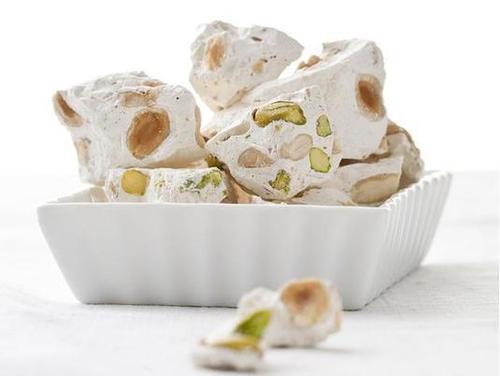See on Scoop.it - Good Things From Italy - Le Cose Buone d’Italia
With its celebratory confections, the presence of torrone on store shelves is a sure sign that the holidays have arrived in Italy. Once produced to honour royalty, torrone boasts a long and glorious history, closely associated to Christmas traditions. Also available year round, the distinctive sweet is typically enjoyed after meals with an amaro or digestif.
While the word “torrone” probably derives from the Latin verb “torrere” meaning to toast, most likely in reference to the toasted nuts from which it is made, its origins, on the other hand, are as varied as the many different types of torroni found throughout Italy.
Some food historians suggest that the recipe derives from Ancient Rome’s cupedia or cupeto (a sweet treat made from honey, almonds and eggs that was offered up to the gods), while others argue that it came from an Arabic indulgence known as turun (made of honey and toasted sesame seeds) introduced to Italy via Sicily.
The famed nougat was, however, first documented in Cremona in 1441 as a dessert created for the marriage of Francesco Sforza and Maria Bianca Visconti by the court’s pastry chefs. Inspired by the city’s famous Torrazzo tower, his delicacy was hence coined torrone.
While this last theory is highly debatable, there may be some truth to the tale seeing that torrone has been a specialty of the Lombard city since the 16th century.
Torrone has been considered a valuable treat and was often gifted at Christmas by influential people. In the 17th century, the torrone of Benevento became a popular Christmas gift, so much so that it was sent to the high priests in Rome, thus creating the tradition of torrone as a celebratory sweet.
Aside from its festive appeal, the flavour combination of torrone became the inspiration behind other beloved treats. It even evolved into a popular gelato flavour, as well as being the predecessor to chocolate bars such as Toblerone and Milky Way.
Types of Torroni
While the production process of torrone went from being an artisanal one to a commercial one thanks to the industrialization of the 19th and 20th centuries, the recipe for this brittle has remained fairly consistent.
The notable Italian nougat made from honey, sugar, egg whites and toasted almonds or other nuts is made in dozens of variations across Italy. Each bears its signature texture and taste, ranging from the crunchy and crumbly duro to the softer and tender morbido varieties. No matter the name or type, torrone is a sweet holiday tradition worth of being passed on.
Here is a collection of some of the most famous torroni:
• The region of Campania is famous for its classic crumbly hazelnuts Torrone di Benevento along with the Torroncino Croccantino or Torrone Bacio. The latter, smaller in size, is made with sugar, honey, crushed hazelnuts and almonds and coated in chocolate.
• Abruzzo produces the Torrone morbido al cioccolato (a soft chocolate torrone).
• The area of Caltanissetta, Sicily, produces the cubaita made with toasted almonds, sesame seeds, honey and orange peel (much like its Arabic predecessor).
• The soft torrone of Sardinia is made with honey, egg white, almonds, hazelnuts and walnuts.
• Molise makes the Torrone del Papa, seasoned with figs.
• In Calabria the ciballo is made with peanuts in place of almonds.
See on panoramitalia.com
via Tumblr http://italianentertainment.tumblr.com/post/37333423351
